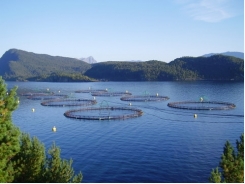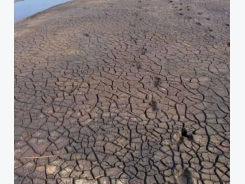Dissolved-Oxygen Requirements In Aquatic Animal Respiration

The amount of oxygen used by aquatic animals varies with species, size, temperature, activity level and other factors
Summary:
In aquatic animals, blood hemo-globin unloads oxygen to the tissue fluids. Coldwater species have higher dissolved-oxygen concentration requirements than warmwater species do. Although carbon dioxide is not highly toxic, high levels in the blood have many negative physiological consequenc-es. As carbon dioxide increases, higher dissolved-oxygen tension is necessary to load hemoglobin with oxygen. Small fish use much more oxygen than large fish. Oxygen consumption roughly doubles with a 10° C increase in temperature.
Aquatic organisms absorb molecular oxygen from water and use it to oxidize organic compounds and release energy for doing biological work. In the process called respiration, they also must expel carbon dioxide, the resulting waste.
Fish blood contains the pigment hemoglobin, which combines with molecular oxygen and allows blood to absorb much more oxygen than will dis-solve in the hemolymph (blood fluids). Shrimp and other crustaceans have the pigment hemocyanin, which differs from hemoglobin in containing copper rather than iron. The loading and unloading of hemoglobin and hemocyanin with oxygen are controlled by dissolved-oxygen ten-sion in water and hemolymph.
Oxygen Tension
Oxygen tension refers to the pressure of dissolved oxygen in water. Water satu-rated with dissolved oxygen has an oxygen tension of about 160 mm Hg – the partial pressure of oxygen in the atmosphere.
The concentration of oxygen at satura-tion varies with water temperature (Table 1), but the tension of oxygen-saturated water remains the same. For the purpose of loading hemoglobin with oxygen, there is no difference in water at 20° C and 9.07 mg/L dissolved oxygen and water at 30° C with 8.30 mg/L dissolved oxygen.
Oxygen tension in water typically is higher than in the blood entering an aquatic animal’s gills from the venous system. Oxygen dissolves in the hemo-
lymph and loads onto the hemoglobin. In the tissues of an aquatic animal, oxygen is used rapidly, and tissue fluids have a lower oxygen tension than oxygenated, arterial blood from the gills. Thus, hemo-globin unloads oxygen to the tissue fluids.
The relationship between oxygen tension and the percentage saturation of hemoglobin is called the oxyhemoglobin dissociation curve (Figure 1). The shape of the oxyhemoglobin dissociation curve is usually sigmoid for warmwater species and hyperbolic for coldwater species.
As a result, warmwater species have a greater capacity than coldwater species to unload oxygen at the tissues. This is a major reason for the requirement of coldwater species for a higher dissolved-oxygen concentration than needed by warmwater species.
Carbon Dioxide
Carbon dioxide released during res-piration by tissue cells dissolves in tissue fluids and is transported by venous blood to the gills. Water usually has a lower carbon dioxide concentration than that in the blood in the gills, and carbon dioxide diffuses into the water.
A high carbon dioxide concentration in water interferes with the diffusion of carbon dioxide from the blood to water. High carbon dioxide in the blood depresses blood pH and has many nega-tive physiological consequences. High carbon dioxide levels also interfere with the loading of hemoglobin with oxygen.
As carbon dioxide concentration increases, higher dissolved-oxygen ten-sion is necessary to load hemoglobin with oxygen (Figure 2). Thus, a high carbon dioxide concentration at a time when dissolved-oxygen concentration is low is particularly undesirable

Figure 1. Oxyhemoglobin saturation curves for warmwater and coldwater fish.

Figure 2. Effect of carbon dioxide concentration on saturation of hemoglobin with oxygen
Carbon dioxide is not highly toxic to fish and other aquatic animals, but in experimental units, they avoided con-centrations of 10 mg/L or greater. Most species tolerate up to 60 mg/L or more of carbon dioxide if there is plenty of dis-solved oxygen. High carbon dioxide con-centrations do, however, have a narcotic effect on fish.
Oxygen Use
The amount of oxygen used by aquatic animals varies with species, size, temperature, time since feeding, degree of physical activity and other factors. Aver-age oxygen consumption rates for adult fish usually are between 200 and 500 mg oxygen/kg fish/hour.
Assuming an oxygen consumption rate of 350 mg/kg/hour in a 1-ha pond with 1 m average depth, each ton of fish would use an amount of dissolved oxygen equal to 0.84 mg/L in 24 hours. However, small fish use much more oxygen than large fish – 10-g channel catfish were reported to use 1,050 mg oxygen/kg fish/hour, while 500-g fish used only 480 mg oxygen/kg fish/hour. One hour after feeding, channel catfish consumed 680 mg oxygen/kg/hour, but after fasting overnight, the hourly rate dropped to 380 mg/kg.
Tilapia forced to swim against a 60-cm/second current consumed oxygen twice as fast as those swimming against a 30-cm/second current. Oxygen con-sumption is also strongly dependent upon temperature – the rate roughly doubles with a 10° C increase in temperature within the temperature tolerance of the species. Although less data are available on oxygen consumption by crustaceans, it appears that shrimp consume oxygen at rates similar to those of fish.
Table 1. Solubility of oxygen in freshwater at different temperatures from moist air at 760 mm Hg pressure.

Perspectives
In pond aquaculture, the main pre-caution to avoid low dissolved-oxygen concentrations is to not apply more nutrients and organic matter in fertilizer and feed than can be assimilated, but this depends upon the amount of aeration used. Normally, aeration should be pro-vided at about 1 hp for each 400 to 500 kg of production, but dissolved-oxygen concentration should be monitored – especially between midnight and dawn – to confirm adequate aeration.
Warmwater fish usually survive at dissolved-oxygen concentrations as low as 1.0 m/L, while coldwater fish normally survive at 2.5-3.5 mg/L dissolved oxygen. However, fish and other aquatic animals are stressed, susceptible to diseases and grow slowly at low dissolved-oxygen concentrations.
As a general rule, dissolved-oxygen concentrations in culture systems should not be allowed to fall below 50% of satu-ration (about 80 mm Hg). In freshwater at sea level, 50% saturation is around 5 mg/L at 15° C and 4 mg/L at 26° C (Table 1).
Carbon dioxide is removed from water by aeration, but in an emergency where fish are stressed by low dissolved-oxygen concentration, lime can be applied at 25-50 kg/ha to lower carbon dioxide concentration.
Related news
Tools

Phối trộn thức ăn chăn nuôi

Pha dung dịch thủy canh

Định mức cho tôm ăn

Phối trộn phân bón NPK

Xác định tỷ lệ tôm sống

Chuyển đổi đơn vị phân bón

Xác định công suất sục khí

Chuyển đổi đơn vị tôm

Tính diện tích nhà kính

Tính thể tích ao



 Lake, Reservoir Characteristics Affect Cage Culture Potential
Lake, Reservoir Characteristics Affect Cage Culture Potential  Drying, Liming, Other Treatments Disinfect Pond Bottoms
Drying, Liming, Other Treatments Disinfect Pond Bottoms